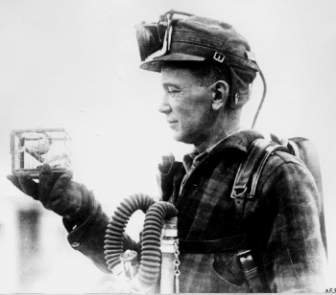
Mine Safety and Health Administration
Small cage with canary bird used in testing for carbon monoxide gas, 1928.
The Police perhaps explained it best in their 1980 song, “Canary in a Coal Mine:”
“First to fall over when the atmosphere is less than perfect…You get so dizzy even walking in a straight line,” Sting sang.
It’s a literal interpretation of a phrase that has recently been tossed around to describe Germany’s economy, veteran’s healthcare, and blue collar workers.
But what on earth is the connection between this bright yellow Tweety bird and deep, dark underground coal mines? What does it REALLY mean?!?

Mine Safety and Health Administration
Mine Rescue Corps returning from scene of explosion with canary in resuscitation cage. Credit: Mine Safety and Health Administration
Travis Deti of the Wyoming Mining Association described it like this:
“The canary in the coal mine is a very rudimentary miner safety technique. Miners would take it down underground in a cage. If there were poisonous gases in the mine, it would die.”
So if there was a methane or carbon monoxide leak, the birds, being more sensitive, would die first, giving the miners time to escape. A canary in a coal mine is really just something that serves as a warning to others.
“Back in the old days, when they had nothing else, I suppose it was as effective as possible, Deti said. “But as far as American mining goes, it is ancient technology.”
Canaries were replaced long ago by gas monitoring sensors and shafts to ensure proper airflow into and out of the mine. But the phrase, however misused, endures.

Mine Safety and Health Administration (MSHA)
The canary’s early replacement: a Monoxor Carbon Monoxide Indicator
Ben Zimmer, in a Wall Street Journal piece, described it like this:
“The canary-coal-mine metaphor has seen better days, its health imperiled by overuse. A once lively figure of speech has been deadened into a cliché for any early warning signal…It may be time, however, to let the canary escape its metaphorical cage and fly free from the language.”







